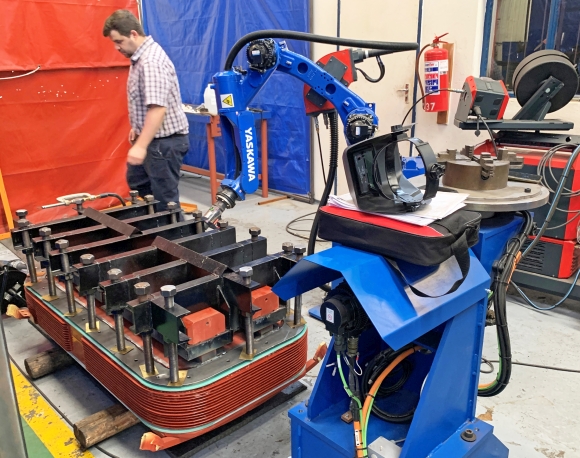Metalplus has harnessed the advanced technology of its recently-acquired automated robotically operated cold metal transfer (CMT) welding system to perform intricate repairs on the coil retaining plates of the salient poles of a 45MW generator.
The generator is one of four identical units deployed at City of Cape Town’s 180MW Steenbras pump storage hydroelectric power station in the Western Cape.
Marthinusen & Coutts (M&C) has the maintenance contract for the 4 x 50MVA 10-pole Siemens motor/generators and due to the age of the salient poles coils the coils had to be re-insulated.

The steel retaining plates that hold the coils in place have to be removed in order to remove the coils for re-insulation. One of the biggest factors when refitting and welding the retaining plates back after the coils have been re-insulated is to ensure that there is as little heat transfer as possible into the coil windings. Heat is one of the major causes of ageing/degradation of the insulation in the coil windings.
M&C approached Metalplus – its sister division in ACTOM – to determine if it could perform the welding component of the contract to the stringent standards of workmanship required. Having been given this assurance M&C subcontracted all the welding work to Metalplus.
“In addition to the complex procedures we had to perform to meet the stringent requirements of the job, we also had to take into account the extremely short time-frame we were given to complete it in,” Roman Mornau, Metalplus’ Divisional CEO, pointed out.
The steel retaining plates also had a history of cracks in the previous welds between the salient pole core and coil retaining plates. M&C attributed the cracks in the welds to the centrifugal forces during operation.
The first step towards performing the welding subcontract was to qualify the weld procedure on test pieces.
“To achieve this we had to programme the feed speed of the filler material and the travel speed of the robotic arm to achieve the desired weld geometry for welding a single run to complete the entire weld,” Roman explained.
“After several tests we determined the ideal weld preparation dimensions of the coil retaining plate, as well as all weld parameters, and then sent the test plates to a metallurgical laboratory to analyse the weld for sufficient penetration and also to ensure that the heat input was sufficient for good sidewall fusion between the retaining plate and the salient pole core.”
Care had to be taken to avoid subjecting the insulation under the retaining plate to excessive heat during the welding process.
“We therefore had to design the weld so that the filler material didn’t penetrate further than the plate thickness, while at the same time the length of sidewall fusion had to be maximised,” he remarked.
Once all these parameters had been correctly determined and tested, it was a relatively simple task to programme the CMT system and perform the welding work on each of the rotor’s 10 salient pole cores in turn.
“We did the entire project from start to finish, including the weld testing and weld procedure specification, within two weeks, week-ends included,“ Roman stated.

